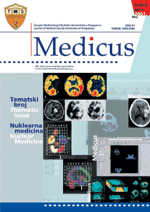|
ABSTRACT
Hashimoto’s thyroiditis is an autoimmune
disease characterized by lymphocytic infiltration of the thyroid
gland, fibrosis and destruction of thyroid follicular cells. In
this study, we examined the effectiveness of levothyroxine management
on the volume of the thyroid gland in patients with Hashimoto’s
thyroiditis who were odserved during one-year period.
The study was performed at the Department of Nuclear Medicine, Clinical
Centre in Banjaluka. Sixty patients were randomly chosen in regular
medical consultations. The examinees were divided into two groups
depending on their hormonal status (the first group - 40 patients
suffering from hypothyroid, the second group - 20 patients that
were euthyroid when the diagnosis was established).
Both groups received levotiroxine in the dose depending on degrees
of the disease 50-150 mg/day during one-year period. The diagnosis
of Hashimoto’s thyroiditis was confirmed by metabolic tests with
J
(1,85 MBq J
per os), scintiscan of gland, measuring of triiodthyronine and thyroxine
(radioimmunoanalisys, original sets „Vinča“ Beograd) and thyroidstimulating
hormone, thyroglobulin and thyroglobulin autoantibodies (original
sets „Inep“ Zemun) levels, the echosonography of the thyroid gland
(„real time“ ultrasound with 5 MHz linear transducer) and fine-needle
aspiration biopsy of the thyroid. The thyroid gland volume was determined
by ultrasound at the time when the diagnosis was proved following
the regular cheching after 3 months, 6 months and one year.
All the patients had an increased volume of the thyroid gland (27,2
ml - 82,8 ml) during the first testing. Three months later there
was statistically significant increase of the thyroid volume in
the first group (p<0,05; t 3,946), but not in the second group (p>0,05;
t 1,681).
Six months later, the results compared with the previous period
of 3 months showed that there was statistically significant increase
of the thyroid volume in the first group (p<0,05; t 3,555), but
not in the second group (p<0,05; t 3,555). Significant correlation
of the thyroid volume increase was not obtained between one year
and six months in both groups, but there was significant correlation
of the thyroid volume increase in both groups between one year and
initial measurement (p<0,05; t 4,899; p<0,05; t 3,754).
The influence of levothyroxine on the volume increase of the thyroid
gland in Hashimoto’s thyroiditis might be explained by reduction
of stimulation of the thyroid tissue by circulating of TSH as expressed
in hypothyroid patients, and decreased anti-ms Ab and anti-tg Ab
as a result of the decreases of immunological stimulation of lymphocytes
by thyroid gland antigens, as expressed in euthyroid patients. In
hypothyroid patients with Hashimoto’s thyroiditis levothyroxin caused
an increase in the thyroid volume. In euthyroid patients with Hashimoto’s
thyroiditis a one-year tretmant with levothyroxine causeda decrease
in the thyroid volume.
All patients with Hashimoto’s thyroiditis with the increased volume
of the thyroid gland can be treated with levotiroxine in the dose
depending on the stage of the disease in order to decrease the gland
volume.
Keywords: Thyroid gland, Autoimmune
disease, Hashimoto’s thyroiditis
ABBREVIATIONS: HHT-Hashimoto
thyroiditis, RIA-radioimmunoanalisys, T4-thyroxine, T3-triiodthyronine,
TSH-thyroidstimulating hormone, tg-thyroglobulin, anti-tg ab-anti-thyroglobulin
antibody, anti-mc ab- anti-microsomal antibody
|

